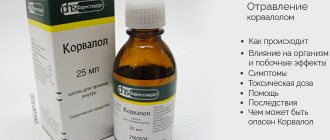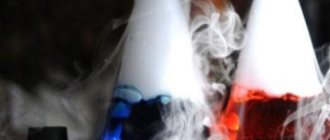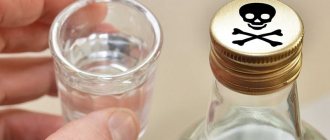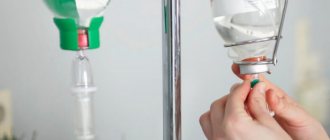hydrogen sulfide
Although hydrogen sulfide is rare in nature, it is very common in the human environment. People encounter hydrogen sulfide everywhere: in the home, at work, and in small concentrations this compound is even found in the intestines. It is impossible to avoid its presence in life, and it is easy to get poisoned.
In what cases does sulfur compound poisoning occur? Does everyone have the opportunity to encounter such a substance or is it just a matter of chance? And how to remove hydrogen sulfide from the body if it is accidentally consumed?
How does hydrogen sulfide poisoning occur?
Being highly volatile, hydrogen sulfide enters the body primarily through the respiratory tract, but can also be absorbed through intact skin.
Being a highly toxic substance, it has a strong irritating effect on the mucous membranes of the eyes and respiratory tract, causing pathological changes in the central nervous system; like cyanides, it inhibits the functions of oxidative enzymes and provokes disruption of interstitial respiration processes.
Poisoning with hydrogen sulfide is possible when staying in industrial premises where the maximum permissible gas concentration is exceeded (in the air of the work area - 10 mg/m3). The severity of intoxication is determined by the concentration of the gas in the air and the time of exposure, for example, the lethal concentration is 830 mg/m3 for 30 minutes or 1100 mg/m3 for 5 minutes.
Hydrogen sulfide poisoning is usually acute and occurs when:
- violation of safety regulations at work;
- violation of technological processes;
- emergency situations.
Often, workers in industries where hydrogen sulfide is used or released are regularly exposed to small doses of gas, which can lead to occupational chronic hydrogen sulfide intoxication.
Hydrogen sulfide poisoning in domestic conditions is unlikely.
Hydrogen sulfide baths - benefits and harms
One of the effective physiotherapeutic methods of treatment is the use of mineral waters containing hydrogen sulfide. Depending on the concentration of the substance, they can be weakly, moderately and strongly sulfide (from 10–50 mg/l to 250 mg/l of the substance and above). People who often resort to such help are concerned about the safety of such treatment methods. The benefits and harms of hydrogen sulfide baths have long been studied by health workers.
Hydrogen sulfide baths will perfectly help with many pathologies, including:
- for skin diseases;
- diseases of the nervous system;
- endocrinological pathology;
- cardiovascular processes.
Poisoning does not occur at such concentrations of the substance, but complications may occur in people with diseases of the respiratory system, pulmonary tuberculosis, after repeated myocardial infarction and kidney disease.
Symptoms of poisoning
Acute hydrogen sulfide poisoning can vary in severity.
In mild intoxication, the main symptoms are caused by the irritating effect of H2S: copious nasal discharge, lacrimation, conjunctival hyperemia, feeling of sand in the eyes, burning and soreness in the nasopharynx, hoarseness.
In case of moderate poisoning, local symptoms are accompanied by signs of systemic action of the toxin: headache, dizziness, nausea, vomiting, diarrhea, severe weakness, motor incoordination, increased heart rate, hypotension. On external examination, a cyanotic coloration of the skin is noted.
Severe poisoning is characterized by disruption of the cardiovascular (tachycardia, arrhythmia, severe hypotension, thready pulse) and respiratory (shallow, unproductive breathing, shortness of breath) systems. The neurotoxic effect is manifested by depression of consciousness or psychomotor agitation, a state of euphoria, often the victim is stunned or inaccessible to contact, and coma may develop.
When exposed to extremely high concentrations of hydrogen sulfide (1000 mg/m3 and above), a fulminant or apoplexy form of poisoning may develop: after a few breaths, tonic and clonic convulsions appear, loss of consciousness and coma occur. There is a high probability of death due to paralysis of the respiratory or vasomotor centers.
Chronic hydrogen sulfide intoxication manifests itself in various clinical forms:
- toxic neurasthenia (asthenovegetative syndrome), in which the phenomena of irritable weakness predominate (asthenia, emotional instability), sweating of the feet and palms, decreased skin sensitivity, vision and hearing are noted; women may develop menstrual irregularities;
- encephalomyelopolyneuropathy, manifested by headache, dizziness, optovestibular disorders (the feeling that the floor is disappearing from under your feet, walls are tilting, the ceiling is falling, etc.) of varying intensity, severe apathy or excessive concern for well-being, the appearance of tactile and auditory hallucinations is possible;
- polyneuropathic form, manifested by sensory disturbances up to complete anesthesia, pain and weakness in the limbs, along the nerve trunks, and progressive loss of muscle mass.
Source: depositphotos.com
Why is sulfur oxide dangerous?
Strong poisons include sulfur oxides: dioxide and trioxide. These are toxic gases that, even when inhaled in low concentrations, lead to painful effects. The reagents have a destructive effect on many organs:
- inflammation of the upper respiratory tract;
- damage to lung tissue;
- mucous membranes of the eyes;
- circulatory system;
- digestive organs;
- nervous structure.
Sulfur dioxide is especially dangerous when it interacts with sulfuric acid salts, which can accumulate in the respiratory system. Such contact can provoke serious diseases leading to destruction.
Poisoning with the reagent leads to both local and general toxic syndrome. Above a concentration of 1.2 mg/l, cellular respiration is blocked and tissue redox functions are inhibited. This leads to oxygen starvation and death.
In cases of sulfur oxide poisoning, dangerous symptoms include loss of smell. People working in production may not feel the gas and thereby limit their ability to leave a place with a polluted atmosphere in time.
In everyday life, sulfur poisoning most often occurs. Gas entering the eyes can cause blindness. If you stay near a toxic substance for a long time, you can suffer suffocation and pulmonary edema.
On city streets there is danger from a suffocating veil of smoke, which includes sulfur dioxide. Chad produces industrial enterprises, factories and oil depots. Sometimes it falls to the ground in the form of acid rain. In this regard, severe and sometimes progressive poisoning may occur.
Toxic reagents can form in sewers. Therefore, prolonged exposure to such systems can lead to intoxication of the body.
First aid for hydrogen sulfide poisoning
- Evacuate the victim from the contaminated area.
- Provide access to fresh air (open windows, doors, unbutton tight clothing).
- If the victim is unconscious, place him on his side or on his back with his head turned to one side to prevent possible aspiration of vomit.
- Rinse your eyes, nose, and exposed skin with a 2% soda solution (1 teaspoon of soda per 200 ml glass of water) or plenty of running water, and rinse your mouth.
- Apply cool lotions to the eyes with 3% boric acid.
- Place 1-2 drops of Vaseline oil into your eyes.
- Provide plenty of alkaline drinks (mineral water, milk).
Therapy
After sulfur poisoning, after studying the victim’s symptoms, doctors prescribe appropriate treatment. In such cases, complex therapy is prescribed:
- if poison enters the stomach, the patient is given a gastric tube;
- to accelerate the excretion of chemical compounds in the urine, the patient is prescribed diuretics;
- for symptomatic treatment, as well as improving blood supply to the brain, doctors prescribe vitamin B6, Encephabol;
- to relieve pulmonary edema, calcium chloride or gluconate is used intravenously;
- oxygen pillows are used;
- prescribe medications to improve the functioning of the peripheral and central nervous system;
- Glucocorticoids will help restore carbohydrate, protein, fat and mineral metabolism;
- Antibiotics will help kill bacteria.
Any burns that appear are carefully washed and treated. If the patient's condition is serious, strong narcotic analgesics are used. After treatment, the patient remains in hospital for about a week under medical supervision. But even after this time, the victim must be registered with medical staff and constantly undergo examinations. This is done in order to prevent many ailments that occur after sulfur poisoning.
When is medical attention required?
If there is a suspicion that intoxication is caused by hydrogen sulfide, it is necessary to seek medical help in 100% of cases.
Treatment is symptomatic: in case of a collaptoid state, anti-shock therapy is carried out, in case of convulsive syndrome, sedatives are administered, etc.
The antidote to hydrogen sulfide is methemoglobin, therefore, in case of severe poisoning, administration of chromosmon or a 1% solution of methylene blue in glucose (10 ml of blue per 20 ml of glucose) is indicated - as a result, methemoglobin is formed, which binds hydrogen sulfide.
What it is
Hydrogen sulfide is the simplest compound of sulfur and hydrogen atoms. It has other names - hydrogen sulfide, hydrogen disulfide. It is a gaseous substance with a peculiar unpleasant odor of rotten eggs. It is highly flammable; in high concentrations it is explosive when combined with oxygen. It dissolves well in alcohol, but the process is worse in water.
It is produced in a minimal amount in the human body during the rotting of food residues in the intestines. Affects the transmission of nerve impulses.
Hydrogen sulfide is found in nature, industrial and mining sectors, and chemical activities. The compound often forms as a result of the decomposition of rocks and sulfide minerals. Due to some of its properties it is used in medicine.
At minimal concentrations it is not capable of causing serious harm to the body. The mechanism of action is such that hydrogen sulfide can disrupt a person’s sense of smell. After some time, he ceases to feel the unpleasant odor, the result is severe intoxication with negative consequences.
Possible consequences
Complications of acute hydrogen sulfide poisoning can include:
- systematic headaches;
- persistent hyperthermia with chills;
- eczema, contact dermatitis;
- conjunctivitis;
- gastrointestinal diseases (pancreatitis, hepatitis) of toxic origin;
- bronchitis, bronchopneumonia, pulmonary edema;
- thyroid diseases;
- renal failure;
- myocardial dystrophy, myocardial infarction;
- encephalopathy (often with intense neurological and intellectual defects).
Diagnostics
The diagnosis is made based on questioning the victim, questioning eyewitnesses, assessing the scene of the incident and later examination methods in the hospital. These include a detailed examination of the patient:
- the air he exhales will smell like rotten eggs,
- Blood pressure is lowered
- pulse – frequent, weak filling,
- skin – pale with a bluish tint,
- breathing is rapid or absent (in severe cases).
Laboratory tests in the blood indicate hyperlactacidemia, a decrease in pH below 7.3. Signs of hypoxia - a decrease in the partial pressure of oxygen. Decrease in calcium content and increase in magnesium in venous blood.
The ECG shows tachycardia and signs of myocardial dystrophy. With pulmonary edema - x-ray changes - “the appearance of “butterfly wings”.
Hydrogen sulfide poisoning requires treatment in a hospital. You can provide first aid yourself.
Briefly about the substance
The opinion that it can negatively affect only those who work in the chemical industry is erroneous. Anyone can be harmed by sulfur and its compounds, as they are used in various industries:
- as part of preparations for disinfection;
- as components of insecticides;
- in the production of acids and sulfites;
- for the production of bleaches in the textile industry;
- in the production of explosives;
- as part of food preservatives.
That is, a person in everyday life can often encounter sulfur and accidentally become a victim of its toxic effects.
Places where hydrogen sulfide accumulates
Hydrogen sulfide is a colorless flammable gas. The source of formation of the chemical element is a combination of sulfur and organic substances. The activity of the reaction depends on the thermal state of the air: the higher the temperature, the more intense the transformation. The process is accompanied by a specific smell of spoiled eggs.
Hydrogen sulfide is a product of microbial transformation. Its accumulation is found in various places:
- sewerage systems of populated areas;
- wastewater treatment plants;
- workshops of enterprises engaged in the industrial production of fur, textiles, leather products;
- premises of metallurgical, chemical, pulp and paper plants;
- oil storage tanks;
- cesspools of private houses.
In small concentrations, the chemical compound can be found even in a household trash can if it is not sanitized for a long time. Due to the prevalence of the gas, you need to be ready to provide first aid to the victim, recognizing the signs of hydrogen sulfide poisoning in the ailment.











